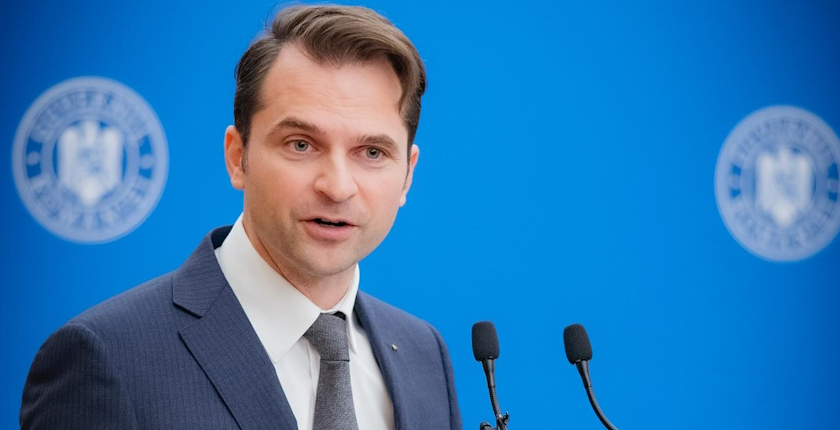
Photo: Sebastian Burduja / Facebook
Romania expects up to EUR 19 billion in offshore wind power investments and to commission as much as 7 GW by 2035, the new roadmap reveals. Minister of Energy Sebastian Burduja said the country is going through an energy revolution. The Neptun Deep project will make it the number one gas producer in Europe in 2027, he claimed. Hidroelectrica is considering a floating solar power project with Masdar, the minister pointed out.
Romania has the ambition to build the first offshore wind farms in the Black Sea. The World Bank issued the Offshore Wind Roadmap for Romania after a two-year project with the International Finance Corp. (IFC), funded by the European Commission’s Directorate General for Structural Reform Support.
Minister of Energy Sebastian-Ioan Burduja said the government would complete the study on optimal locations next year. It also vowed to build modern and flexible electricity networks capable of integrating both wind energy and nuclear energy, he stressed.
Burduja: Romania is on the radar of major global investors
The proposed update to the Energy Strategy of Romania envisages 3 GW in offshore wind capacity in 2035, Burduja added. “We are indeed on the radar of major global investors,” he stated and noted that the World Bank earlier estimated the country’s potential at 76 GW.
Floating plants would account for 54 GW. The offshore wind roadmap highlighted wind speeds of 7.5 to eight meters per second.
Romania is going through an energy revolution, Burduja underscored ahead of the roadmap’s launch.
Ministry obtained EUR 14 billion in grants for energy projects in free market
The Ministry of Energy obtained almost EUR 14 billion in grants to be deployed in the free market in the past 15 months, Burduja said, referring to the period since he took office. The sum includes support for an overall 10 GW in solar and wind power, 3.5 GW for gas-fired power plant projects and over EUR 1.5 billion for the transmission and distribution network, he explained.
The ministry has just signed contracts for EUR 152 million from the European Union’s Modernisation Fund. The grants are for the country’s gas and electricity transmission system operators (TSOs) Transgaz and Transelectrica, respectively, and regional power distributors Rețele Electrice Muntenia and Rețele Electrice Banat.
Their projects are worth EUR 188 million in total.
Additionally, Burduja claimed Romania would become the top gas producer in the EU in 2027 with its Neptun Deep offshore project in the Black Sea. He also revealed that state-owned Hidroelectrica is considering a floating solar power pilot project with Masdar.
They are examining the possibility of installing such facilities on seven reservoirs on the Olt river, the minister pointed out. The two companies have launched a joint venture partnership and it would be their first project.
Offshore wind roadmap targets up to 7 GW for 2035
According to the offshore wind roadmap, Romania can add 3 GW to 7 GW in capacity by 2035 in its exclusive economic zone, at locations at least 50 kilometers from the coast. They are predominantly in shallow waters, suitable for bottom-fixed turbines.
In the least optimistic scenario, 150 machines would be installed within five projects. Investments would reach EUR 9 billion, creating EUR 1.4 billion in gross added value.
The intensive growth scenario in the Offshore Wind Roadmap for Romania envisages investments of EUR 19 billion
The 3 GW would cover 16% of the country’s electricity needs. The benefits for the supply chain and the overall economy include an estimated local content of 28% and the creation of 21,000 jobs.
The intensive growth scenario implies 360 windmills through seven projects, for 7 GW in total. The capacity would be equivalent to 37% of demand in 2035. Investments are seen at EUR 19 billion.
Local content could amount to 38% and the number of new jobs is estimated at 77,000. The supply chain buildup would create EUR 5.3 billion in gross added value for the economy.
Households snatching up subsidies for photovoltaic systems, batteries
The offshore wind power roadmap pointed to impressive potential. But prosumers are still among the main drivers of Romania’s energy transition.
Subsidies from the Casa Verde Fotovoltaice for solar panels for households are being snatched up within two minutes. A new round of applications started last week. It is divided into lots on different days for eight regions, followed by a segment for religious buildings.
The first was the north-west region and today central Romania was up. This year’s budget amounts to EUR 402 million.
Beneficiaries get up to EUR 6,000 each from the Environment Fund Administration (AFM) for photovoltaic installations of at least 3 kW. Households participate with up to another EUR 603 per grant. The new round features funds for battery storage as well. The minimum capacity of each system is 5 kW.
AFM said it expects 67,000 new beneficiaries to lift the number of prosumers to 200,000.
Of note, the Ministry of Energy scheduled a conference for October 10 for companies interested in participating in the current tender for contracts for difference (CfDs) for onshore wind and solar power projects.


















Be the first one to comment on this article.